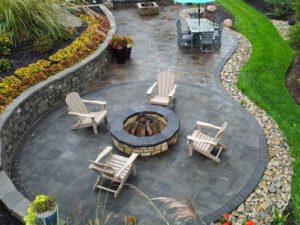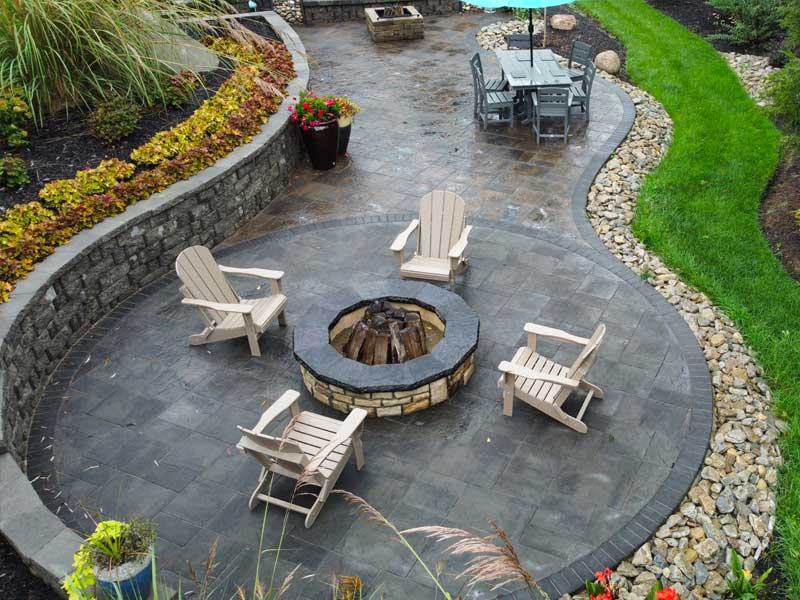A concrete patio is the ideal choice to transform a yard and seamlessly connect indoor living spaces with outdoor ones. It also costs less than wood decks and other materials and requires little maintenance.
Before building, clear the area of obstacles. You’ll need a level site that is free of rocks, roots, and steep slopes. For professional help, contact Concrete Contractors Colorado Springs now!
Concrete patios can be designed with a range of modern aesthetics. One way to achieve a sleek, minimalist look is by contrasting the gray concrete with wicker or wood furniture. Another popular option is to use pavers instead of traditional concrete slabs. Pavers are more attractive and versatile, and they come in a variety of colors and textures that can complement any style. Whatever type of design you choose, it’s important to ensure proper installation and drainage for safety and longevity.
The best modern concrete patio ideas combine a variety of materials to create a balanced, unique look. For example, camouflaging concrete walls and fences with wood gives the patio a more natural feel and blends it into the landscape. It’s also a great way to add privacy to your backyard. If you want to highlight a view, glass railings are a stylish and functional option. However, it’s important to use tempered glass that’s thick enough to withstand the elements and accidental impacts.
Using alternative materials on your patio is an inexpensive way to dress it up and make it more appealing to guests. For example, a patterned outdoor rug can break up the monotony of gray concrete and add texture and color to the space. You can also add eye-catching accessories to your concrete patio, such as a brightly colored umbrella or vibrant flowerpots.
Another easy way to improve the look of your concrete patio is to upgrade its stairs. You can do this by matching the material used on the steps with the materials used on the patio, adding lighting, and enhancing the space with plants and landscaping. This design concept creates a seamless transition from indoors to outdoors, giving your home a sense of spaciousness.
Organic Shapes
Incorporating organic shapes into your concrete patio design is an effective way to add an aesthetically appealing look. This style can be achieved by incorporating natural materials like stone or wood into the overall layout of your patio, and it works well in conjunction with organic color palettes. This combination is both modern and timeless, ensuring that your concrete patio will not go out of style.
Organic shapes also work well in conjunction with cool-toned colors. The cooler tones are a great complement to the natural elements of your yard and can help create a balanced aesthetic. The textures of these natural elements contrast nicely with the hard lines of a concrete patio, and they can draw attention away from any imperfections or cracks in your concrete.
Decorative concrete is another way to incorporate organic shapes into your patio design. There are a variety of concrete stamps that can be used to imprint the surface, from block patterns to leaves and fossils. A concrete stain or paint is another inexpensive option, and it can be used to cover an existing concrete patio or to refresh the color of a newly constructed patio.
Incorporating greenery and other natural features into your concrete patio can also enhance the organic feel of the space. Adding planters or other decorative elements with an organic shape can help to draw attention away from any imperfections in your concrete and can also add a pop of color that accentuates the beauty of the plants.
Concrete patios can also be complemented with wood retaining walls to create a more visually interesting separation between areas of the yard. If you have a more spacious backyard, this can be a great way to divide your outdoor living spaces while still maintaining the ability to flow freely between them.
Sleek Aesthetics
Concrete patios are often drab and uninspired, but they don’t have to remain that way. There are several ways to enhance the aesthetics of a concrete patio and create a more appealing outdoor living space for relaxing and entertaining guests.
Adding color and texture to your concrete patio is one of the easiest and most cost-effective ways to transform its appearance. Opting for contrasting shades of gray can make the patio feel more dynamic and vibrant, while earthy tones can give it a warm and inviting ambiance.
You can also add visual interest to a concrete patio by using decorative paint or concrete stain. Use a stencil or painter’s tape to outline the design or pattern you want to create on the surface, then apply the appropriate paint according to the manufacturer’s instructions. Allow the first coat of paint to dry completely before applying the second coat and allowing it to dry again.
A concrete patio can also look more elegant with the addition of stairs that connect it to other areas of your garden or home. This feature creates a seamless transition and elevates the overall look of your patio.
Incorporating a fire pit into your concrete patio is another easy way to improve its aesthetics and create an intimate and cozy ambiance. A fire pit adds warmth and a focal point to the patio, making it an ideal spot for relaxing with friends or family members.
If your concrete patio is in an open outdoor space, you can boost its appeal by adding a privacy screen or fence to block out neighboring homes and other visual distractions. A wooden privacy fence will work well with a concrete patio, but you can also opt for metal or glass railings to complement your existing design.
Plants and garden beds
Growing flowers and vegetables in raised garden beds is a popular way to beautify a concrete patio. When planting your garden, choose locations with access to sunlight. Vegetable gardens typically require 6–8 hours of sunlight each day for best results.
You can build your raised bed using a wooden frame, or you can use cinder blocks to create a border. Whichever method you choose, be sure to line the bottom of the bed with weed barrier fabric. This prevents toxic chemicals in the frame from leaching into the soil and makes it easier to maintain the plant bed.
The soil you use in the raised bed is critical to your plants’ health. Look for a rich, well-draining mix that includes perlite and sand. You can also add organic matter to the soil to promote healthy growth and help water drain faster.
Since the soil in a raised bed is closer to the surface than in the ground, drainage issues can be a problem. To ensure that your plants are properly hydrated, it’s important to water them slowly and deeply. Use a soaker hose or drip irrigation, and mulch around the plants to help retain moisture.
If your raised garden beds are in close proximity to the concrete, you may experience staining and discoloration on the surface of the patio. To avoid this, keep your raised beds away from regular walkways and consider constructing a PVC system for running a watering hose to the beds.
Water Features
Concrete water fountains are a great way to create a focal point on your backyard patio. They are available in a variety of shapes and sizes and can be customized with your choice of color or a custom-coloring solution to suit any landscape design. A fountain also creates a relaxing ambience on your backyard patio.
A basic concrete slab is the most affordable option and can be finished with a smooth surface or a textured finish, which mimics the look of brick. Expect to pay $6 to $11 per square foot, including labor.
The cost of a concrete patio can vary by region. A contractor will charge more for a job in Phoenix than in Ridgeway, Colorado, for instance. It’s important to get the estimate for your specific project in writing before you begin any work.
Measure your site to determine how large your patio will be, and check the local building codes to make sure you don’t need a permit for excavation. If you don’t, use a tape measure to mark the dimensions on your site and then stake it. Drive the stakes about a foot apart and attach a string to them with a line level between each one.
To prepare the area for pouring, shovel in and level crushed stone to help with drainage and reduce the risk of cracking once the concrete is poured. Dig down to a depth of about two feet, and then add wood 2x4s around the perimeter of the dig area to create a frame to pour your patio into.
To keep your concrete from cracking, add rebar or steel mesh to the top of the form boards. You can buy reinforcing fibers to add to your own concrete mix or have them added to ready-mixed concrete delivered by truck.
